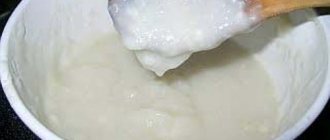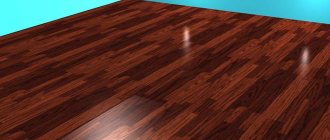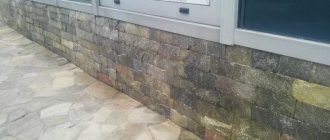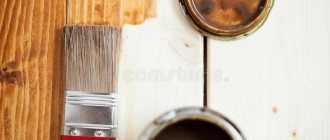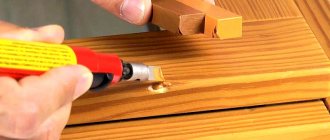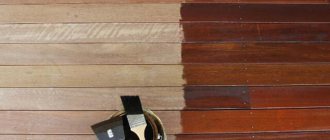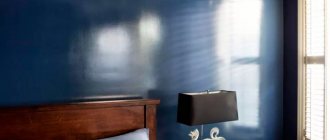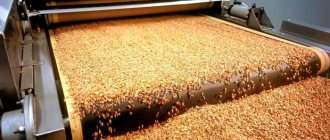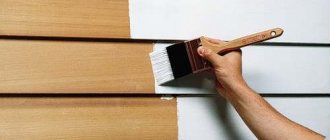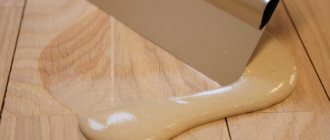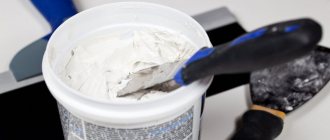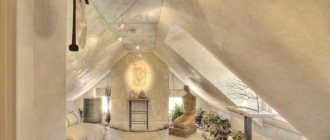Alkyd types of dyes and varnishes are used for application to such substrates as:
- End parquet (the components in the mixtures do not glue the ends together, which makes it possible to eliminate tension).
- Heated parquet flooring.
- "Floating" floors.
- Parquet floors are made from soft wood, with a high level of sensitivity to environmental influences.
The advantages of alkyd compositions are as follows:
- High degree of resistance to sudden changes in temperature and humidity.
- The material absorbs vibrations and is also resistant to other similar loads.
- Alkyd varnishes are not endowed with adhesive properties, which prevents squeaking of painted surfaces.
- Decorative properties. Alkyd compounds saturate porous substrates well, emphasizing their original texture.
- Depending on your wishes, you can choose an alkyd composition with a glossy or matte effect.
- Ease of use. Due to the fact that the consistency of the alkyd product is quite viscous, it covers the surfaces well and evenly (spreads over them).
- They have a high level of resistance to serious mechanical loads (they are difficult to break through). Also not susceptible to chemicals.
- Prevents the formation of mold and fungi and rot.
Along with the advantages, there are also some disadvantages of using:
- The period for complete drying of alkyd varnish compositions is quite long (at least one day). But, if necessary, you can purchase two-component alkyd products (varnish + harden), which dry for a shorter period of time.
- The second drawback is even more unpleasant, as is the persistent smell of alkyd, which does not go away during the entire time the surface dries. The only thing that can help a little is good ventilation of the room.
- If more material was used during painting (that is, the layer turned out to be too thick), the coating may wrinkle. The optimal amount of varnish that must be used for application per 1 m2 is no more than 120 grams.
- Painted surfaces are not very resistant to external influences. Due to this, their service life is reduced (usually no more than 2-3 years).
What it is?
Alkyd varnish is a mixture that contains various synthetic alkyd resins with organic solvents. The product has good adhesion and a high level of moisture resistance.
Alkyd varnishes are actively used for working with various types of surfaces.
- End parquet. Alkyds do not allow the ends to stick to each other, so surface stress is eliminated;
- Parquet floors with “warm floor” system;
- "Floating" floors;
- Parquet made from delicate types of wood that are highly sensitive to the environment.
When this varnish hardens, it forms a transparent and fairly hard layer. Many people say that alkyd products take a long time to harden. However, manufacturers have developed products with special additives, with the help of which they shortened the polymerization time. This means that the surface can be used after a short period of time.
After polymerization, a glossy or matte film is formed on the alkyd varnish, depending on the chosen product. The material that you will process with such a mixture will be provided with reliable protection against irritants of any type. Applying the alkyd mixture is quite simple, since the product has a thick consistency, due to which the product spreads well over the floor and other treated surfaces, creating a dense layer of film.
Parquet varnish - which one to choose: features of different models
Respectable parquet flooring requires special treatment. If a plank floor can simply be “covered” with paint, then the parquet must be covered with varnish or special wax (or oil), otherwise it will quickly lose its attractiveness. In addition to the aesthetic purpose of the varnish coating, it serves as good protection for the board, without which the service life of the parquet is significantly reduced.
Which parquet varnish to choose?
Which parquet varnish to choose is a question that arises among homeowners who are installing parquet boards. In addition to varnishes, the assortment of construction stores includes a large selection of various compositions for protecting and transforming wood, but varnish, as the most reliable and proven product over the years, is still the most popular today.
Parquet varnishes can have different bases, so before choosing the one you need, you need to familiarize yourself with the characteristics of some of them.
Criteria for choosing parquet varnish
When choosing the composition of the varnish for parquet, you need to take into account the type of wood from which the board is made, since it can have light and dark shades, so the varnish must match its color. In addition, each of the rocks has its own density, and its absorbency depends on this property of the material.
Varnishes are available for sale in a very wide variety
When choosing a varnish, the purpose of the room in which the parquet is laid is also of great importance, that is, the intensity of traffic, humidity and types of loads to which the coating will be subjected. If the varnish will be used to cover the floor in a room in an ordinary apartment where a small family lives, then there is no need to choose a varnish that can withstand heavy loads.
But even in such conditions, you need to take into account the specific room. For example, for a hallway or kitchen it is better to purchase varnishes with the ability to experience higher loads, since these rooms have high traffic and are cleaned more often. Therefore, in this case, the protective properties of the composition should be an order of magnitude higher.
A high-quality varnish coating should both emphasize the beauty of wood and serve as reliable protection for it.
For public buildings and premises with a high intensity of human flow, you need to pay attention to the strength of the varnish, since it will have to withstand mechanical stress from numerous heels and dust and dirt carried on shoes. In such places, oil impregnations or durable water-repellent compounds are often used, which will help keep the parquet flooring in good condition for a long time. Moreover, such a floor is easier to renew, unlike varnish coatings. Therefore, varnish is used extremely rarely in this case.
It is also necessary to remember that inexpensive compositions are not particularly durable and will last no more than 2 ÷ 3 years, and given that the process of applying varnish is quite a labor-intensive task, it is better to immediately choose a reliable composition that will keep the floor in its original condition for 12 ÷ 15 years. Naturally, its price is many times higher, but by using it, you can save yourself from many problems for a long time. These varnishes include two-component compositions.
There is no need to think that material produced abroad will necessarily be of higher quality and more durable. First of all, you need to pay attention to the chemical composition of the varnish, and not to the country in which it was produced. Some imported products are not of high quality, have an unpleasant odor, take a long time to dry and wear out quickly.
It is very important to pay attention to the consumption of the composition. For example, five liters of high-quality varnish should be enough to cover an area of 15 ÷ 17 m² in three layers, 20 ÷ 25 m² in two layers, you can stretch it to 30 m² of a room, but the layers will be thinner.
Also, you need to pay attention to the container in which the varnish is sold, since high-quality compositions are never sold in wholesale containers or plastic buckets - this is usually how counterfeits of imported varnishes from well-known manufacturers are packaged.
The varnish must be packaged in cans or plastic canisters with a volume of no more than 5 ÷ 10 liters. If this is a two-component version of the varnish, then a bottle of additional composition should be attached to the main container. They are mixed together in the strict proportions indicated on the packaging, immediately before application to the parquet.
So, when buying varnish, you need to pay attention to the following characteristics:
- Parquet varnishes are produced on different bases - urethane-alkyd, alkyd, polyurethane, formaldehyde and water-based. These parameters are indicated on the packaging in the chemical composition section.
- The material can give a coloring effect or be completely transparent and retain the natural color and texture of the wood.
- The consistency of the varnish can be viscous or fluid - the method of applying it to the surface will depend on this parameter.
- The composition can give different aesthetic effects - matte, silky-matte, semi-matte or semi-gloss and glossy.
- In addition, the packaging indicates susceptibility to moisture, resistance to stress, wear resistance and approximate service life.
Types of varnishes for parquet
To make the right choice, you need to know what each type of varnish is.
Primer varnishes
Primer composition for further varnishing of parquet
The very name of such varnishes suggests that their purpose is to prepare the surface for layers of finishing coating. Primer varnishes impregnate the wood, and this promotes better adhesion when applying the next main layers. If the parquet is treated with primers, the quality of the front coating improves several times. But besides this, the use of such starting processing contributes to:
- reducing the adhesive effect of the top layers of varnish at the joints of individual dies;
- creating a perfectly smooth surface and highlighting the textured pattern of wood;
- protecting the surface and side parts of the dies from possible exposure to moisture;
- preservation of natural protective oils of valuable wood species.
Primer varnishes are selected depending on the basis on which the finishing coating will be made, since these compositions must be compatible with each other and have good adhesion.
The primer should ensure high adhesion of the floor surface to the upcoming application of varnish
If the materials are incompatible, the work will be completely damaged and will have to be redone, as the surface will be covered with light spots. This problem can only be corrected by removing the varnish or sanding the entire floor.
For example, if a water-based varnish is purchased for finishing, then the primer should be exclusively water-based - then the parquet will have an even and reliable coating.
It is also very important that the surface coated with a primer tends to absorb the finishing varnish less, which means it significantly reduces its consumption.
Primed parquet will absorb less varnish during final application.
Primer varnishes made on different bases dry quite quickly, since some of them are absorbed into the surface of the parquet wood, and the remaining excess quickly evaporates. The drying time of the first primer layer ranges from 20 minutes to 3 ÷ 4 hours.
To achieve the desired result and get a beautiful surface, craftsmen recommend using a primer and finishing composition made by the same manufacturer. This is due to the fact that the composition of these varnishes is designed to be fully compatible with each other; in fact, they represent a single “system”, so they have excellent adhesion and will never cause any “undesirable reactions”. By choosing formulations from different companies, you can get an unpredictable result that is unlikely to please you.
Water-based varnishes for parquet
Water-based varnishes are the most popular due to the fact that they do not have an unpleasant odor and dry quickly enough. When choosing such a material, it is better to purchase two-component compositions, since when dry they provide a more durable, moisture-resistant coating than one-component options.
One of the most popular are water-based parquet varnishes.
This varnish includes microscopic particles of solvent and emulsifiers mixed with water, so it dries somewhat differently than materials on other bases. After the composition is applied to the primed surface, water first evaporates from it and only then the solvent, which undergoes a concentration process before evaporation. Further, after its evaporation, a hard and durable film is formed on the surface of the parquet.
Water-based varnishes can be divided into three categories based on their solvent content:
- The first of them includes compositions where this component is completely absent;
- the second category includes water-based varnishes containing no more than 5% solvent;
- the third category contains solvent at a rate of 15%.
All three categories of varnishes, regardless of the amount of solvent in them, have good adhesive properties with wooden surfaces, and therefore are excellent for both solid boards and parquet.
It must be said that water-based varnishes must be applied to the primed surface of the parquet, in order to avoid penetration of the varnish between the dies. Moisture, getting between them, can be absorbed by the wood and subsequently lead to creaking in the parquet. By the way, according to many craftsmen, you should not use water-based varnishes at all for parquet floors, since there is always a risk of an unpleasant squeak, even if a primer was previously used.
These varnishes also have a number of other significant disadvantages that you need to be aware of when purchasing the material:
- One-component water-based varnishes, consisting of water, solvents and emulsifiers, have low wear resistance and therefore wear out quickly. Two-component varnishes have a longer service life and perfectly protect the wood surface, but only if this composition is applied in a room where the humidity is 50%. Such an atmosphere in the rooms cannot always be achieved, especially in winter when the heating is on.
- To ensure that the surface of the water-based varnish is smooth after drying, it must be applied using a roller, since tampons, sponges, spatulas and even brushes are absolutely not suitable for this process.
Water-soluble varnish should be applied only with a roller.
The pronounced positive qualities of water-based varnishes include the following properties:
- The absence of unpleasant pungent odors, such as from varnishes made with organic solvents - this factor especially attracts owners of apartments with a small volume of space. However, you don’t need to think that the varnish has absolutely no odor - it is still present, but not as strong and pungent as other compositions.
- Water-based varnishes are not flammable, so they are used in rooms where, according to fire safety rules, it is prohibited to coat surfaces with compositions based on flammable substances.
There is one more secret that is good to know before buying water-based varnish. If you purchase a professional varnish, then it can be applied to an unprimed surface. If the packaging does not indicate the “professional” category of a particular composition, then treating the floor with a primer before applying it is necessary.
Alkyd varnishes
Alkyd varnishes are made on the basis of resins obtained from natural raw materials by transesterification of vegetable oils, glycerin and rosin, alcohols and acids. Due to the presence of oils in their composition, varnishes have the ability to be absorbed into the structure of the wood, thereby creating its reliable protection from external mechanical damage and exposure to moisture.
Alkyd varnishes probably have more disadvantages than advantages.
Alkyd compositions also contain quite toxic substances, such as white spirit, so when buying this product for parquet, you need to choose a composition with the lowest concentration of this substance. Like any other varnish option, alkyd has its positive and negative qualities, which you need to know about when purchasing this product for finishing parquet.
Glossy and semi-gloss, semi-matte and matte types of alkyd varnishes are produced, from which you can choose the one that is more suitable for a particular parquet.
The positive properties of alkyd varnishes include:
- Deep penetration of the substance into the structure of the surface being coated.
- The alkyd composition enhances the textured beauty of wood, giving it an aesthetic appearance.
- The varnish has a viscous consistency, so it does not flow between the dies, which means that after the coating dries, there will be no squeaking when walking on the parquet.
- It is not affected by changes in temperature and humidity, and also has high resistance to mechanical stress.
The negative properties of the compositions include the following points:
- The varnish applied to the surface takes a long time to dry and requires special drying conditions.
- Drying the varnish must be carried out at not too high temperatures, since this process can take a long time, therefore, when a film forms on the varnish, it is best to create a small draft by opening doors and windows;
- Since the consistency of the varnish is quite thick, when applying it to the surface you need to carefully monitor the thickness of the layer, otherwise when it dries, wrinkles may form in places where the layer is thicker;
- Alkyd varnishes are characterized by rapid abrasion, so the coating will often have to be renewed. In a word, this type of varnish is more suitable for covering furniture than flooring.
The coating turns out to be beautiful, but, alas, short-lived.
If you want to get a high-quality and durable parquet coating, then it is better to refuse alkyd varnishes, even though they also have certain advantages, which have already been mentioned.
Polyurethane varnishes
The polyurethane type of varnish is excellent for rooms with high traffic intensity, as it is extremely wear-resistant and has high adhesive properties. This type of parquet covering material can be one- or two-component, and is marked PUR and DD.
"Champions" in wear resistance - polyurethane varnishes
Polyurethane varnishes can be made on different bases - urethane or acrylic. Depending on the base, the compositions have different smells, but, unfortunately, all of them are not very pleasant. Since polyurethane varnish contains no water at all, it dries much faster than the water-soluble version. The hardening of this varnish begins with the evaporation of the solvents included in its composition. Then a chemical process of polyaddition undergoes, as a result of which the varnish hardens.
Once cured, the result is a coating of exceptional durability.
During the period of applying the composition to the parquet, as well as when it dries, it should not come into contact with water. Parquet wood should have a moisture content of no more than 6-8%, but if it exceeds this figure, the work can be spoiled by the appearance of air bubbles, peeling or even foaming. As a result, defects will be clearly visible on the surface of the parquet.
The polyurethane composition of the varnish, like all others, has its advantages, but has almost no negative qualities.
The positive aspects of the polyurethane composition include the following:
- After the coating hardens, it becomes moisture resistant, as it forms a kind of film on the surface of the parquet.
- The resulting film is quite elastic and does not tighten the surface structure of the parquet wood.
- This coating does not require preparation of the parquet surface with primers.
- After hardening and polymerization, the coating does not respond to changes in temperature and humidity in the room.
- Parquet coated with polyurethane varnish is perfectly protected from mechanical influences and abrasive loads.
We can say that this varnish has one significant drawback - if it gets into the cracks of the parquet, it glues its individual elements together, which is generally undesirable for such a coating.
Otherwise, the polyurethane varnish version can be called the best for covering parquet, since it is suitable for rooms with any intensity of load.
Video: water-soluble two-component varnish for parquet based on polyurethane
Formaldehyde varnishes
There are also two-component parquet varnishes on sale, one of the components of which is an acid or formaldehyde hardener. Such varnishes are considered the most durable and reliable.
Two-component acid parquet varnish
However, even just the name of the composition is frightening, since a substance such as formaldehyde is dangerous to human health.
It should be noted that this element in the varnish plays the role of a hardener. When the varnish completely hardens, there is no longer a trace of this dangerous component left in it. During the hardening process, formaldehyde evaporates, so working with this varnish is necessary with the mandatory use of respiratory protection (a respirator), and the drying process should be carried out with the windows open.
The coating turns out excellent, but special precautions should be taken when working
The advantages of formaldehyde varnishes are as follows:
- They have excellent adhesion to wood;
- It is possible to apply varnish with any tool convenient for the master.
- This coating does not require preliminary priming work, which allows saving on pre-treatment of parquet;
- The material is highly resistant to changes in humidity and temperature;
- This varnish coating is wear-resistant to all types of loads.
Negative properties of varnishes containing formaldehyde:
- This type of varnish easily flows into the cracks between the dies, as it has a fairly liquid consistency;
- The composition initially has an unpleasant, pungent odor and is quite toxic, so you will have to take precautions when applying it.
Find out if there is a vacuum cleaner for parquet floors and how to choose the right model from our new article.
When choosing a specific varnish composition for covering parquet, you should get additional advice from salespeople directly in the store and carefully study the annotation located on the packaging. Based on the characteristics that this publication introduced you to, it will be easier to understand the intricacies of the choice and make a truly successful purchase.
Prices for types of varnishes for parquet
Parquet varnish
Video: the right choice of paints and varnishes for wooden and parquet floors
Description
The composition of alkyd varnish includes various synthetic resins, organic solvents and driers. These varnishes have a good adhesion rate and an excellent level of moisture resistance. Nowadays, the use of alkyd varnish is varied; it is used in the following areas:
- for processing end parquet. Since alkyd resins do not allow the ends of parquet dies to stick together, it is alkyd compounds that are used to treat wooden parquet, which prevents the occurrence of surface tension;
- to protect parquet floors where a heated floor system is installed;
- for covering floating floors;
- in order to extend the service life and protect parquet made from rare, delicate types of wood, which are very sensitive to various factors, including temperature and humidity.
Once the alkyd varnish is completely dry, it forms a very durable, hard and transparent protective coating. Some people are hesitant to use alkyd compounds because they think they take a long time to dry. But nowadays, manufacturers have developed special additives that greatly reduce the polymerization time of varnish. Many people are interested in how long does alkyd varnish with drying accelerators take to dry? Final polymerization will take approximately 1-2 days.
When the varnish polymerizes, it produces either a matte or glossy surface, depending on which product was chosen. Wood or metal that is treated with an alkyd solution becomes visually attractive and reliably protected from various negative factors, including chemicals, high humidity, various liquids, etc. Alkyd mixtures are applied very easily and quickly, they have a thick structure, spread well over the surface, while creating a fairly dense coating. One of the effective and popular varnishes is the product of the Kudo company; varnish solutions are produced in the form of aerosols and liquid mixtures.
Types and categories of protective coatings
The degree of toxicity, chemical composition and technical characteristics of each common category called yacht varnish vary, depending on the needs for which certain characteristics are intended. In order to correctly select the required degree of strength and resistance to impacts, it is not enough to simply read the words “deck varnish” on a bright label.
You need to choose from several categories what is truly suitable, and for this you need to know the composition and properties, the degree of reliability and decorativeness, and rational intended use. Based on their composition, all varnishes for this purpose are divided into:
alkyd;
alkyd-urethane;
from urethane and alkyd;
acrylate.
A good varnish for wood will not only protect the material from external influences, but will also give the surface a picturesque and decorative quality, making the wood an independent element and a semantic accentuation of a certain interior.
Wooden country houses, comfortable wooden cottages with heated floors, or the interior lining of a room will take on a more expensive and picturesque look if the natural parts of the interior are varnished. A properly selected composition will avoid troubles associated with toxic fumes.
For future decorativeness and picturesqueness, it is of no small importance which of the 2 categories the developer chose: matte or glossy surface. The matte composition is more practical and does not become covered with dust; the glossy composition is good as a decorative component, but collects dust and requires additional care
Gloss varnish is common where appearance rather than durability of the coating is considered the main determining factor, but not every paint will look good under a matte layer.
Advantages and disadvantages
The advantages of alkyds include the following properties:
- solutions are resistant to temperature changes and humidity changes. There are no competitors for alkyd varnishes in this area;
- increased level of vibration resistance;
- the composition does not have adhesive qualities. Therefore, floors treated with this varnish will not creak;
- high decorative qualities. The product is able to penetrate deeply into the wood, thereby highlighting the natural beauty of the product;
- easy application due to thick consistency;
- after polymerization, the varnish forms a matte or glossy film;
- optimal resistance to mechanical loads;
- alkyd varnishes are resistant to contact with chemicals;
- mold or mildew does not form on the surface.
Among the disadvantages, users note the following qualities:
- The varnish takes a long time to dry. Polymerization takes more than a day. However, as described earlier, some manufacturers add special hardeners that shorten the hardening time;
- Until the surface dries, the varnish emits an unpleasant odor, which can be dangerous if inhaled. In order not to harm your body, you must leave the windows open until the product hardens;
- Alkyd products can wrinkle if you apply too much varnish to the surface. Therefore, the instructions for use should be followed;
- The service life of the surface is about 3 years.
Alkyd-urethane varnishes
Recently, an alkyd-urethane mixture, where alkyds interact with polyurethanes, has gained particular popularity. Alkyd-based compositions are modified with a special component - toluene diisocyanate. After this, the alkyd resin acquires additional molecular weight. This allows you to change the drying mechanism: first, the solvent evaporates, and then hardening occurs due to the exposure of the coating to oxygen.
Unlike pure alkyd varnishes, alkyd-urethane compositions dry faster. They are more resistant to moisture, temperature changes and mechanical stress (especially friction). The service life of surfaces coated with an alkyd-urethane mixture is significantly increased . Therefore, despite the higher cost of these paints and varnishes, their use is more than justified.
About half the volume of alkyd-urethane varnishes is an organic solvent. This makes such a material unsafe from a fire and toxicological point of view (in this case, the advantage of acrylic aqueous compositions is obvious). Thus, the use of alkyd-urethane paints and varnishes requires compliance with increased safety requirements.
It is also worth noting one more nuance associated with varnishing with alkyd-urethane mixtures. If you do not wait the required time for the applied layer to dry, then when applying the varnish, defects will arise that can only be eliminated with the help of a sander.
Specifications
The constant and main component of varnishes is alkyd resin, which acts as a base. Among similar products, alkyd varnishes are unrivaled in terms of resistance to temperature fluctuations.
Vibration loads do not in any way affect the quality of the applied alkyd composition; in addition, the varnish does not have the adhesive qualities that many representatives of paint and varnish products have. The product is absorbed directly into the wood and does not penetrate into the floor cracks in the log house. Such product characteristics make it possible to minimize floorboard squeaks when treating the floor with an alkyd mixture.
The first alkyd-based varnish that began to be produced in Russia was the composition PF-231. The product is intended for use on all types of surfaces. One can note the visual attractiveness of the base obtained after treatment with this composition - the film evenly and neatly covers the working surface.
In addition to the positive characteristics, the composition also has some disadvantages. The main disadvantage is the short service life of the coating due to its minimal hardness. Due to this, after 2-3 years the surface of the wooden floor will have to be treated again. On other materials the composition will last many times longer.
PF 283 forms a glossy layer, notable for its decorative properties. Essentially, these products are a mixture of alkyd resin, fatty acids and natural solvents. In addition, the ingredients include a drier. Most often, such varnish is sold in a can as an aerosol of 150 ml.
PF-170 includes resin in combination with specific additives and aliphatic hydrocarbons. The composition can be used for wood, wood-containing materials, metal and ceramic substrates. In addition, bases treated with paints, enamels and primers are very often coated with a protective and decorative composition. The products are allowed for use indoors and outdoors. The varnish is manufactured in accordance with GOST, is resistant to chemical detergents and aggressive environmental factors, allows the surface to “breathe” and is very economical in terms of consumption.
Popular brands
Alkyd varnish PF-231 belongs to one of the first series of parquet varnishes produced in Russia. The composition is easy to apply, and the film looks neat and provides decent protective characteristics. However, the main disadvantage of PF-231 is very significant: the coating does not have a long service life and must be replaced after 2-3 years.
MCh-0163 is a two-component product that includes alkyds, urea-formaldehyde resin, and an acid hardener. In comparison with PF-231, this mixture is more competitive: it resists moisture more reliably and takes mechanical loads better. The disadvantages of MCh-0163 should be considered instability to ultraviolet radiation, insufficient elasticity of the film coating, a rather pungent odor, and the possibility of bubbling on the surface during varnishing.
EP-2146 is a one-component composition with good performance properties. Epoxy resin is used as a modifier here. EP-2146 has decent hardness, moisture and abrasive resistance. EP-2146 is used for varnishing parquet, veneer, fiberboard, chipboard, plywood.
Benefits and harms
The advantages of alkyd varnishes include the following characteristics:
- resistance to temperature and humidity fluctuations;
- vibration resistance;
- lack of adhesive properties;
- high decorative qualities of the resulting coating;
- when using a brush, the composition is applied very quickly, since it has a thick consistency;
- after drying, a glossy or matte film forms on the base;
- resistance to mechanical loads;
- the composition does not lose its properties upon contact with chemical compounds;
- prevents the formation of mold or mildew on the material.
According to consumer reviews, the following disadvantages of alkyd compositions stand out:
- Complete polymerization of the mixture requires quite a lot of time, usually about a day. To eliminate this disadvantage, most manufacturers began to include hardeners in the composition, which help reduce the time required for the mixture to dry.
- A base that is not completely dry and treated with alkyd varnish has a sharp, specific odor that is dangerous to human health. To eliminate the risk of vapor poisoning, the room should be well ventilated while the film is curing.
- Excessive amounts of alkyd mixture will certainly wrinkle the base, so when working with the product you must follow the instructions.
The best yacht varnishes for exterior use
The coatings contain a large number of toxic substances, so applying them without a mask and gloves is prohibited. At the same time, products for external use are highly resistant to negative external factors. After finishing, wooden structures will be reliably protected from moisture and UV rays, which significantly increases their service life. Analysis of user reviews made it possible to identify the 2 best yacht varnishes out of 5 nominees.
V33 Vernis Bateau glossy
The coating with a urethane-alkyd base is enriched with resins that increase the surface's resistance to the aggressive effects of the marine environment. It protects wooden structures from the negative effects of a humid climate. Paints and varnishes are used when finishing various types of wood. The next layer is applied after 6 hours and released into containers with a volume of 0.75 l, 2.5 l, 5 l.
Advantages
- Colorless;
- Makes the coating waterproof;
- Abrasion resistant;
- Gives the surface a glossy shine;
- Low consumption;
- Not susceptible to sea salts.
Flaws
- High price;
- For exterior use only.
Users confirm the quality and reliability of the product. All characteristics correspond to the parameters specified by the manufacturer. Paintwork protects the surface from negative mechanical and atmospheric influences, extends the life of wooden structures.
Rust-Oleum Marine Coatings Spar Varnish
Transparent varnish provides chemical resistance, protection of wooden structures from water, UV rays, sea salts, and mold. It can be applied to a surface that was previously covered with stain or paint. Before the procedure, the product is diluted with white spirit. They produce paints and varnishes in tin cans with a volume of 0.95 liters. Complete curing occurs after 72 hours.
Advantages
- Low consumption;
- Increases the strength of coatings;
- Easy to use;
- Good degree of adhesion.
Flaws
- High price;
- Persistent unpleasant odor.
The product can be applied at temperatures from +10 to +32 C and humidity less than 85%. In this case, direct sunlight should be avoided. The coating dries quickly, but when finishing structures made of cedar or other species with a high oil content, the time may increase.
Kinds
Alkyd varnishes are divided into the following groups according to type and form of release.
One-component
Conventional varnishes containing only an alkyd-resin base. Before use, the product is diluted with a solvent in the proportion recommended by the manufacturer. If the ratio of base and thinner is not maintained, the composition will turn out to be too fluid, which will complicate its application and reduce the strength characteristics of the varnish film.
Such coatings do not have high strength characteristics, so they are most often used for varnishing furniture, wall cladding, and decorative elements. The advantages include a long shelf life in printed containers and a low price. The disadvantages include the need for a long break between applying several layers (24–48 hours).
Two-component
They are produced in two packages: the first contains the alkyd varnish itself, and the second contains the hardener. Before application, the compositions are mixed in the ratio specified by the manufacturer, which is not recommended to be violated. If you add too much hardener, the composition may begin to thicken before the end of application. If you add too little drying agent, increasing the drying time can lead to insufficient strength of the varnish coating and dust adhesion.
The advantages of drier varnish based on alkyd resins are fast drying (the composition must be applied within 8 hours), as well as higher performance characteristics. Two-component varnishes are significantly superior in strength, water resistance and wear resistance to their one-component counterparts. Disadvantages include an unpleasant odor during application and drying, as well as a possible decrease in the transparency of the varnish film when exposed to sunlight.
The main purpose of drying varnishes is the coating of wooden floors, as well as the treatment of external wooden structures.
Alkyd-urethane
This type of paintwork material is made from an alkyd resin modified with toluene diisocyanate, as a result of which its molecular weight increases. This leads to a change in the drying process of the varnish coating: first, the volatile substances of the solvents evaporate, and further hardening of the layer occurs as a result of an oxidation reaction.
The advantages of alkyd-urethane compositions are their improved properties compared to conventional alkyd varnishes, such as abrasion resistance, resistance to prolonged exposure to water and ultraviolet radiation, and mechanical strength of the film. In addition, such varnishes dry faster, but between applying layers it is necessary to take a break of at least 24 hours to avoid the effect of the previous layer dissolving. Among the disadvantages of alkyd-urethane varnish, a high content (up to 50%) of solvents is noted, which makes the process of applying the composition fire hazardous and toxic. Therefore, compliance with safety measures is very important when working with such paintwork materials.
Yacht varnish
A separate category includes the so-called yacht varnishes - improved compositions for effectively protecting wood from atmospheric influences and water, including sea water. In addition to their direct purpose (coating decks and other elements of boats and yachts), such paints and varnishes are used for processing wooden facades, gazebos, garden furniture and other surfaces exposed to weathering.
A significant disadvantage of yacht varnishes is the use of toxic substances for their production - toluene and xylene, thanks to which the coating obtains its basic properties. Therefore, such compositions are recommended for external use, although some manufacturers produce special types for interior use.
In terms of their composition, yacht varnishes are alkyd, urethane-alkyd and alkyd-urethane. In the last two compositions, the percentage of alkyd resins and urethane modifiers changes.
Alkyd varnish for metal
For the protective coating of metals against corrosion, compositions based on alkyd resins modified with various polymers have been developed. Such varnishes form a durable, mechanically resistant film with high adhesion to various metals (ferrous, galvanized, non-ferrous). Available for both domestic use and industrial use. In addition to water resistance, such coatings are antistatic, can act as an electrical insulating layer, and are resistant to thermal and chemical influences.
How to choose alkyd varnish
You need to choose a varnish carefully and be sure to familiarize yourself with its different types before purchasing.
The product must meet certain criteria, only in this case the work will be successful and the coating will be used for the longest possible period of time.
- It is necessary to take into account the strength of mechanical loads on the surface. If they are not serious (implies operation by two to three people), it is recommended to use water-based varnish compositions.
- If you plan to varnish the flooring in the kitchen or hallway, it is better to give preference to mixtures with pigments. They protect the surface well from contamination and dust and other small particles will not cling to them. A good alternative for covering kitchen floors would be to use a non-aqueous polyurethane mixture. It is easy to apply, interacts well with surfaces and is easy to care for.
- To cover floors exposed to serious mechanical loads (for example, offices, restaurants, etc.), it is better to choose varnishes that have a high level of moisture resistance.
Yacht varnish products
Yacht varnishes are used for application to wooden surfaces (yachts themselves). But this does not mean that it cannot be used to cover other surfaces that are operated at high levels of humidity or are constantly in contact with water.
However, such materials are not suitable for painting substrates indoors. This is due to the fact that they are toxic and unsafe.
Some of the main additives are xylene and toluene.
Of course, such compositions are very durable, strong and resistant to moisture, but it is extremely undesirable to apply them to parquet floors or furniture that is used in residential buildings or other similar premises.
Criterias of choice
When choosing an alkyd varnish, the following aspects must be considered:
- The choice of varnish type depends on the surface that you plan to cover with it. For wall cladding and decorative elements, a one-component alkyd product is suitable; for indoor flooring, it is better to use alkyd-urethane, and for outdoor use or deck covering, it is optimal to use yacht varnish.
- For floor coverings, you should choose wear-resistant types with maximum water-repellent effect.
- Some manufacturers add coloring pigments to varnishes that are transparent in nature. Such compositions are designed to provide maximum protection for wooden floors from dirt and water, and expand the decorative functions of the varnish coating.
Advice! For interior work, choose varnishes with a minimum amount of solvent, which are less toxic.
Properties of yacht varnish
Protection from moisture is the main function of this coating, which leads to a number of additional effects. The elastic layer of waterproofing protects against temperature changes, mechanical wear, and exposure to sunlight.
The colorless composition favorably emphasizes and preserves the natural texture, giving the wood not only strength, but also aesthetic durability.
The ability to choose different degrees of reflection - from mirror to matte, and easier surface care give undeniable advantages to this varnish. But the content of toxic elements makes it impossible to use it in closed spaces.
Poor resistance to low temperatures limits the scope of use outdoors. Modern manufacturers offer special compositions of yacht varnishes with improved characteristics.
Consumption
Many people are interested in how much alkyd varnish costs. This indicator depends on the type of mixture and your talent. Experts advise applying 2-3 layers of varnish. Each level should be applied only after the previous one has dried. Thus, it will take you at least 3 days to treat the surface.
The consumption of alkyd products is 50-75 grams per square meter. If you use more varnish than required, the polymerization time will increase. You also risk getting a less durable surface.
Before use, some brands should be diluted to a working consistency with xylene or solvent. You can mix one of these drugs with white spirit in a 1:1 ratio.
Choosing a varnish for acrylic paint
Modern trade can offer its customers a huge selection of paint and varnish products. For every taste and budget, in any volume and any composition. From any manufacturers.
This article offers acrylic paint varnish for consideration. Why it is needed and where it is used was described above. Now let's look at how to choose such a varnish, what parameters you should pay attention to.
Main parameters for selection:
- The varnish must contain acrylic.
- The varnish must be fresh. No more than three months should pass from the moment of its manufacture.
- It is better to choose a matte varnish, since acrylic paint itself has glossy properties.
How to dilute it?
White spirit is used as a solvent for alkyd compositions, which begins to evaporate as soon as the composition is applied to the surface.
Then polymerization of the composition occurs. It is caused by chemical reactions between the molecules of resins and other components. To remove the varnish coating from the surface, a remover is used. It is a special chemical that destroys the varnish and lifts the film from the material. The varnish can be washed off with powder products, pastes of different consistencies, as well as by scraping or heat treatment.
Compound
The product necessarily contains alkyd resin as a base. It is most often extracted from natural materials - flax oil or wood. The second most important component is organic solvents. Various fatty acids can also be found in the composition.
When alkyd wood varnish is absorbed into the porous structure, penetration is increased thanks to these solvents. The product is absorbed quite deeply and can successfully highlight the beauty of the wood.
Thanks to these features, alkyd compounds are widely used in finishing work inside and outside. Parquet varnishes allow you to change the appearance of floors almost beyond recognition. With the help of such mixtures it is possible to obtain deeper colors of all shades, thereby emphasizing the special texture of the parquet.
How long does it take to dry?
Immediately after application, alkyd varnish looks like glue. After about 10 hours, some varnishes that have special hardeners in their composition will already harden. Typically it takes 24 hours for one coat to dry.
It is worth noting that the thickness of the varnish film after drying may become smaller, in this case it all depends on how much of the solvent has evaporated. Its content in alkyd mixtures may vary, and based on this indicator, the toxicity level of the composition increases or decreases.
How to choose
It is important to clearly define how the room where the varnish coating will be applied will be used in the future.
Provided that the varnish is applied to the floor, it is important how many people will be in the room at all times. For heavy loads, it is better not to choose alkyd varnishes, but to purchase something water-based.
Alkyd compounds are best suited for those surfaces that will not be subject to abrasive or mechanical impact. Then the surface can last much longer. These products are not suitable for floors in the kitchen and hallway.
Application technique
To achieve maximum protective effect, any type of alkyd varnish is applied in 2–3 layers. It is not recommended to apply the varnish in a thick layer: the average consumption should be 50–75 g/m². When carrying out painting work, the air temperature must not be lower than +5 °C.
Important! Applying a new layer of varnish is possible only after the previous one has completely dried (24–48 hours depending on the type). If you neglect this rule and apply a second layer to a still sticky surface, the coating may wrinkle and will need to be completely removed with a sander. Wrinkles can also form if you apply too thick a layer of varnish in one pass.
Before applying varnish, the surface to be treated must be cleaned of dirt and dust, and any old peeling paint or varnish coating must also be removed. Wooden surfaces are sanded with fine sandpaper until matte. Wood exposed to weather conditions must be dried before sanding. Metal surfaces are cleaned of rust, scale, and degreased.
Advice! Wooden surfaces made from fresh wood, as well as those exposed to precipitation, are recommended to be treated with colorless antiseptic impregnations before applying the main varnish coating.
The one-component varnish is thoroughly stirred before use, and if necessary, to increase its fluidity, a solvent is added to it. The two-component composition is mixed in a separate container in the proportion recommended by the manufacturer.
The varnish is applied with a spray gun or brush along the fibers. In this case, it is best to use a paint sprayer for glossy varnish, and apply matte varnish with a brush or roller. To obtain the smoothest possible surface, before applying the second or third layer of varnish, it is recommended to lightly sand the previous layer with fine sandpaper.
Working with varnish indoors
Before applying varnish, the surface must be thoroughly sanded, then cleaned of remaining particles and dust, otherwise unsightly bumps will remain on it. All holes (for example, from nails) are first filled with putty and then sanded.
The next step is applying primer varnish. This operation is especially important before varnishing the parquet. The primer will provide better adhesion of the base material to the surface, remove remaining dust particles, and additionally protect the wood from moisture. In order for the choice to be correct, you must follow several rules.
- The first stage before priming work is to check the composition on a small area of the floor covering. This way you can determine how the composition acts on wood.
- Equally important is the compatibility of the primer varnish with the base varnish. For example, if you decide to use a water-soluble varnish, then the primer material should be the same.
- Drying the primer takes anywhere from 15 minutes to 3 hours, so this process won't take much time anyway since most base coats take much longer to dry.
- Apply primer varnish to the cleaned material along the grain, evenly. The main recommendation is full compliance. The primer and base material must be from the same manufacturer. In this case, there is a guarantee that there will be no unpleasant “surprises” (for example, dried bubbles).
The primer and base varnish are applied either manually - with a roller, wide brush, or spray. Different compositions need their own drying time. The fastest varnishes (alcohol-based) require speed from the master, as they begin to set after 10-15 minutes. “Slow” compositions (water-based) dry from several hours to several days. The period indicated on the product packaging is the time that must be waited before applying the next layer.
To improve the appearance of wood, add tone or enhance the pattern, use tinted varnish or stain. The latter liquid is produced on a water, wax, organic or alcohol basis. Its task is to make the drawing more expressive and contrasting.
Manufacturers
Several brands are in wide demand among buyers:
- White house
- Parade
- Tikkurila
Alkyd-urethane mixtures from Parade were able to win a large audience, since this manufacturer sells varnishes with increased elasticity. Buyers leave reviews in which they report that the film that forms after applying the product does not crack or deteriorate for a long time. Alkyd products can emphasize the naturalness of wood material and make the floor more impressive. Parade offers its customers mixtures for exterior and interior use.
White house has won over customers with its affordable prices and low scent. The manufacturer produces high-quality varnishes that are characterized by high wear protection, rapid polymerization and a decorative component. Varnish is able to preserve the natural shade of wood. Just like Parade, the manufacturer produces products for working with outdoor and home surfaces.
Tikkurila is considered a trusted manufacturer of many materials for construction work. The brand has won the respect of customers and is known as a manufacturer of reliable and high-quality products. Tikkurila yacht varnish, which is characterized by fast polymerization and excellent spreadability, receives good reviews. The low price helps this brand become a leader among alkyd varnish manufacturers.
Latest production technologies
Urethane-alkyd varnish has become very popular throughout the world paint and varnish market. This is a modified composition that has higher performance characteristics. The manufacturing technology is based on the synthesis process of uralkids. During the synthesis process, the components are bonded with special polyurethanes.
The effect of this modification is very high. Thanks to polyurethanes, it was possible to significantly reduce drying time.
Now it is 12 hours. The price of these products is practically no different from the cost of the most common alkyd analogues.
How to varnish water-based paint?
For interior decoration, water-dispersion and water-based paints are increasingly used. There is no fundamental difference between them, and the only difference is the degree of coverage. To preserve the pleasant color of a surface painted with water-based paint, you can use varnishes. But you need to use formulations with similar characteristics.
Water-based paint comes in different types, so each option requires a separate water-based varnish:
- Water-based acrylic paint requires a preliminary application of acrylic primer, and then an acrylic-based water-based paint varnish.
- Silicone-based water-based paint cannot be varnished, since it penetrates deeply into the internal structure of the material.
- Acrylic water-based paint can be treated with medium-viscosity polyurethane varnish. The surface of the walls is easy to clean, the integrity of the coating remains for several years.
- Nitrovarnishes for water-based paint partially dissolve the composition, so they must be used very carefully. In addition, nitro varnishes emit toxins and are best used for outdoor use.
Alkyd varnishes can be used to coat wooden surfaces treated with alkyd enamels. If the wood is painted with water-based acrylic paint, then acrylic varnish is chosen to protect the coating.
The main rule of varnishing technology for various surfaces is that paint and varnish compositions must be included in the same group, that is, have the same characteristics of substances at the molecular level. The use of varnish has both a decorative and protective function, extending the life of products, objects and surfaces.
The best parquet varnish for wooden floors and stairs
Initially, all varnishes are colorless, but they can be tinted as desired. Usually the composition is tinted if you need to combine the floor and stairs with other interior details. When choosing, pay attention to the level of gloss of the product. Glossy will make the room visually more spacious. But matte will emphasize the natural structure of wood.
3V3 Vitrificateur Protection
Parquet varnish 3v3 is produced in three variations and comes in matte, semi-matte and glossy. Provides intense protection to the base thanks to its acrylic filler. This product fully complies with all medical and sanitary requirements, therefore it is completely harmless to humans and the environment.
3V3 Vitrificateur Protection
It is applied to various types of wood, planks, stairs, parquets. A brush or roller is used for work. Drying time to touch-free condition is half an hour; to apply the second layer you need to wait 2 hours, and it takes a day for it to dry completely. Consumption is 12 m2/l. The price of French paint and varnish coating with a volume of 5 liters is 3,400 rubles.
Pros:
- applied in any convenient way;
- dries quickly to touch.
Tex parquet PF-231
Gives high gloss to your surfaces, colorless. They can work on wood, fiberboard and chipboard. Apply only after 24 hours.
Tex parquet PF-231
Specifications:
| Consumption, sq.m/l | 14-22 |
| Time for complete drying, h | 5-7 |
| Time between layers, h | 1 |
2 liters cost 337 rubles.
Eco Protect
The 3v3 formula allows you not to be “fidgety” with the selection of solvent. Economical water-based parquet varnish is odorless, which allows you to work indoors. As a result, you get a wear- and scratch-resistant coating. Thanks to its repellent properties, water and dirt will not be absorbed. Can be applied in several layers, allowing each layer to dry for 24 hours. Apply in a warm place - not lower than 12°C and dry.
Eco Protect
Specifications:
| Consumption, sq.m/ml | 83-100 |
| Time for complete drying, h | 48 |
| Time between layers, h | 24 |
The smallest capacity of 0.75 liters will cost 829 rubles.
Pros:
- matte, semi-gloss;
- won't strip
Minus:
- not suitable for attic or terrace floors.
Varnish EP-2146
The Yaroslavl paints company presents an economical option for covering wooden floors. Can only be used indoors over veneer, plywood, chipboard or fiberboard. Used as a finishing layer. Application should be made along the structural pattern of the tree.
Varnish EP-2146
Specifications:
| Consumption, sq.m/l | 10-14 |
| Time for complete drying, h | 48 |
| Time between layers, h | 2 |
Price 633 rub. for 1.7 kg.
Pros:
- washing with aggressive soap solutions;
- resistant to temperature changes.
Euro Kiri
Alkyd-urethane mixture, for protecting floors, stairs or furniture in the room. Abrasion resistant and water-repellent. A wide palette of 30 shades will allow you to choose a tone to match your decor.
Euro Kiri
Specifications:
| Consumption, sq.m/l | 12-14 |
| Time for complete drying, h | 12 |
| Time between layers, h | 2-4 |
A 2.7 liter capacity costs RUB 1,903.
Plus:
- There is a semi-gloss variety.
Minus:
- do not apply with a roller.
